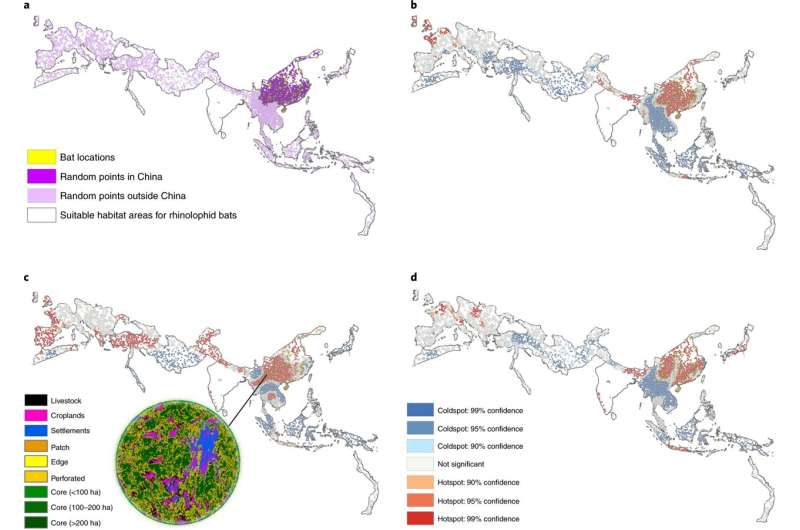June 1, 2021 report
Mapping zoonotic 'hot spots' where risk of coronaviruses jumping from bats to humans is highest

A team of researchers from Politecnico di Milano, the University of California and Massey University has created maps of possible hotspots in Asia and Europe where the risk of coronaviruses jumping from bats to humans is highest. In their paper published in the journal Nature Food, the researchers describe how they combined data regarding human population densities, horseshoe bats, land use and other factors to create their maps and what they showed. Monia Santini, with Foundation Euro-Mediterranean Center on Climate Change, has published a News & Views piece in the same journal issue outlining the known ways that coronaviruses can jump from animals to humans and the work done by the team on this new effort.
The global COVID-19 pandemic has put a lot of pressure on scientists to learn more about coronaviruses and how they can lead to pandemics. One area of research involves the means by which coronaviruses jump from animals, such as bats, to humans. Prior research has suggested that if the places most at risk for such jumps could be identified, then they could be monitored more closely to quickly react when such jumps occur. In this new effort, the researchers have used a variety of resources to find those places most at risk and to map them.
Prior research has shown that one of the major factors involved in viruses jumping from animals to humans is human encroachment on natural habitats. As humans take down forests, some of the animals living in them attempt to adapt by learning to live in the new environment. This leads to interactions between wild animals and domesticated animals and humans. The result can be viruses moving from animals to humans, so call zoonotic disease transfer, or jumping. Thus, to isolate likely hotspots for coronavirus jumping, the researchers looked for recent encroachments by studying satellite images. They also obtained information from existing databases that track wildlife such as horseshoe bats—the only animal that has been found to consistently host SARS-type coronaviruses. They also pulled data from human population databases and from databases that hold information about domesticated animals, most particularly livestock.

The researchers then analyzed all the data and used it to identify certain hotspots around the world. They then marked the hotspots on a map, making it easier for viewers to see patterns and to make risk assessments.
More information: Maria Cristina Rulli et al, Land-use change and the livestock revolution increase the risk of zoonotic coronavirus transmission from rhinolophid bats, Nature Food (2021). DOI: 10.1038/s43016-021-00285-x
Monia Santini, The land use–food–coronavirus nexus, Nature Food (2021). DOI: 10.1038/s43016-021-00290-0
Journal information: Nature Food
© 2021 Science X Network


















